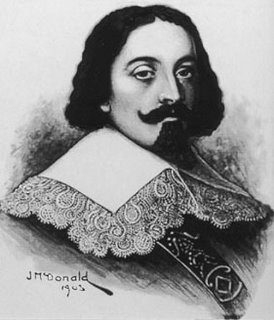26 October: Boreham on Abel Tasman
 Charting a New World
Charting a New WorldWe note today the death, in October 1659, of Abel Tasman, who played a brave part in the shaping of our Austral World. It is more than three hundred years since Tasman, having earlier sighted this island and called it Van Diemen's Land, added still further to his laurels by discovering New Zealand. "We have discovered two countries within two weeks," he proudly told his men, and nobody grudged him the gratification he so naturally felt. For Tasman was one of the most popular commanders whoever sailed these seas. Born in 1603, his patriotism was early excited by the fierce conflicts between Holland and Spain, and he was only 18 when his country became involved in the long agony of the Thirty Years War. Tasman himself, however, took most delight in the maritime prowess of his people. He early imbibed the conviction that the destiny of the Dutch was to be shaped upon the seas, and he looked with longing eyes on every tall ship he chanced to see.
Having signed on as an ordinary seaman, he lost no time in displaying his aptitude for the craft. He earned promotion at incredible speed and within two years was master of a vessel. He was still in his thirties when he was given command of the Heemskerk and the Zeehaen and despatched on that memorable voyage in the course of which he discovered first Tasmania and then New Zealand. Of the two experiences Tasman looked back upon the former of these exploits with the greater satisfaction; the latter was too deeply tinged with tragedy. As soon as the two vessels dropped anchor in one of those blue bays for which New Zealand is so famous, the Maoris treated the newcomers with obvious mistrust. Tasman did not like the look of things and sent seven men from his own ship to warn the crew of the other vessel of the danger he apprehended. The boat containing these men was, however, swiftly surrounded by native canoes, three of the sailors were killed and a fourth mortally wounded, and Tasman, half wishing he had never seen the horrid place, named the spot Bay of Murderers or Massacre Bay and set sail in search of happier conquests.
A Race That Improves Upon Acquaintance
This unfortunate introduction to the Maoris gave them a bad name, especially as the sinister impressions it left were confirmed by later voyagers. More than a century after Tasman, Marion du Fresne, a French navigator, was, with 16 members of his crew, brutally butchered and made the victims of a cannibal orgy. Ship after ship shared the same horrible fate. These sickening stories soon became the property of mariners all the world over and, in every cabin and forecastle on the high seas, the natives of New Zealand were discussed with terror as the most atrocious and bloodthirsty monsters on the face of the earth. For more than a century captains kept a wary eye upon the skyline for the first glimpse of the New Zealand coast and, on its appearance, ordered boarding-nets to be lowered immediately to prevent the dreaded savages coming to close quarters.
Yet, if only Tasman and his successors had known, there was another side to all this. The Maori was a much finer fellow than he appeared. He may, for example, justly claim to be ranked alongside the most enterprising pathfinders of our modern civilisation. The records of his daring voyages would have stirred the blood of Sir Francis Drake and kindled the admiration of Sir Walter Raleigh. Long before our own hardy navigators had fired the imagination of the world with visions of western empires and southern continents, these dauntless explorers, in large and shapely canoes, capable of accommodating and provisioning 150 men, had found their way across the immense spaces of the southern oceans. Long before the Vikings of the North had turned their frowning figureheads seawards, these Vikings of the South had completed voyages as wonderful as any in the history of the world. Monuments of these maritime adventures have been found along the coasts of Chile and Peru; up the banks of the Rio Negro, a great river of Patagonia; which discharges its waters into the Atlantic; and even up the slopes of the Andes and on the great plains of Argentina.
One Of Civilisation's Transformation Scenes
Nor did Tasman suspect, as he hastened to place a wide belt of blue water between himself and these bloodthirsty Maoris, that the swarthy race of which he had formed so unhappy an impression was in reality a people of high culture with the capabilities of imbibing a higher culture still. Even in Tasman's day, and long before, they possessed a wealth of tradition, mythology, and folk lore that has since won the unqualified admiration of the most eminent critics and taken its place as an integral part of the world's imaginative literature. And when this amazing people had the opportunity of infusing into their own life and literature the new spirit that came to them from overseas, an incredible transformation resulted.
In a few years there were Maori doctors, solicitors, clergymen, teachers, and members of Parliament. The people seemed to awake as from some horrid nightmare and take an honourable place among civilised and enlightened nations, while the sons and daughters of this race distinguished themselves in every department of scholarship and in all the arts of peace. It is in this setting, and against this background, that we have to admire the colonising triumph which, in the course of a comparatively short space of time, has enriched the Empire with a Dominion, loyal, vigorous, and united, of which the entire Commonwealth of Nations has ever increasing reason to be proud.
F W Boreham
Image: Abel Tasman


<< Home